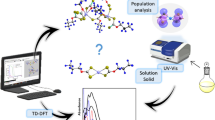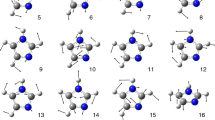Summary
-
1.
The chemical interaction between metals or between metals and metalloids, which results in the formation of various substances having metallic properties, is characterized essentially by the formation of metallic solutions and metallic compounds.
-
2.
The chemical resemblance. and differences between metallic elements, which are associated with the dispositions of the elements in the same or different group of the periodic system, are the fundamental factors determining the possibility of the formation of solid metal solutions. in some cases and metallic compounds in others.
-
3.
In accord with the teachings of Mendeleeev and Kumakov concerning solutions and compounds, it has been shown that there is a close relationship between metallic solutions and metallic compounds. These two kinds of interaction between metals must be regarded in their essential unity. The fundamental laws of dialectical material ism — the transition of quantitative changes to a new quality, and .the unity of opposites — are manifested in graphic form in the transitions of metallic solutions and metallic compounds.
-
4.
The name “metallic compound”, first introduced by Ku rnakov in 1899, is the most satisfactory designation for those products of the chemical interaction.of metals which, their great variety notwithstanding, are distinguished by one fundamental feature, the metallic character of the bond, The name “metallic compound” must be substituted for many indefinite foreign terms that were brought into Soviet science without adequate critical examination e.g. intermetallic compounds, intermediate phases, secondary solid solutions, etc.
-
5.
With the object of gaining the acknowledgement of the priority of Russian science in the discovery of metallic compounds formed as ayesult of thermal transformations of solid solutions, it is proposed. to call them “Kurnakov compounds”. since Kurnakov was the first to. establish, in 1914. the formation of such compounds in the system gold copper, a phenomenon that has since been observed in practically all solid metal solutions.
-
6.
With increase in the chemical difference between metallic elements, as deduced from their positions in different groups of Mendeleev's periodic system, the kind of interaction characterizing the formation of solid solutions gradually passes over to the formation of metallic compounds from liquid solutions.
-
7.
The stability or strength of the bond between atoms of different elements in metallic compounds determines the temperature at which.the compounds are formed: the more stable the compound, the higher the-formation temperature. It has been shown by an examination of some metallic compounds of magnesium, iron and transitional-group metals, that the stability and the formation temperature of a compound,rise as the difference in the chemical properties of the elements increases.
-
8.
The laws of formation. of metallic solutions and metallic compounds are important for the theoretical determination of the nature of the interaction of metals and the prognosis of the types of phase diagrams that will be found in systems not yet studied. This method of predicting the as yet unstudied phase diagrams of simple. and complex metal systems, which is on principle possible, is of great importance, not only for the study of metals now widely employed in practice (iron, nickel, aluminum, etc.), but also for the study of metals forming equilibrium systems that have as yet received little or no study. These metals include chromium, molybdenum, tungsten, vanadium, niobium, tantalum, titanium, zirconium, and hafnium.
Similar content being viewed by others
Literature cited
D. I. Mendeleev. Fundamentals of Chemistry, Vol. 1, 9th Edn., 1931, p. 247.
N. S. Kurnakov, Introduction to Physicochemical Analysis, Acad. Sci. USSR Press, 1940.
G. G. Urazov, Frog. Chem., 21, 9, 1019 (1952).
N. S. Kurnakov, Prog. Chem., 5, 7-8, 13 (1936).
I. I. Kornilov, Prog. Chem., 21, 9, 1045 (1952). Papers read at the Conference on the Theory of Alloys, Acad. Sci. USSR Press, 1952, p. 77.
N. V. Ageev, Chemistry of Alloys, Acad. Sci, USSR Press, 1941; Papers read at the Conference on the Theory of Alloys, Acad. Sci. USSR Press, 1952, p. 38.
V. G. Kuznetsov, Bull. Sect. Phys. Chem. Anal., 16, 4, 68 (1948).
L I. Kornilov, Solid Solutions of Iron, Acad. Sci. USSR Press, 1951.
N. S. Kuraakov, Selected Works, II, 1939, State United Sci. Tech, Press, Moscow and Leningrad. Inst.,
N. S. Kurnakov. S. F. Zhemchuzhny, and M. I. Zasedatelev, Bull. Polytech. Inst., 22, 487, 1914.
N. Norman a, B. E. Warren, J. Appl. Phys. 22, 483 (1951).
I. I. Kornilov, Bull. Sect. Phys. Chem. Anal., 20, 294 (1950),
S. T. Konobeevsky. Sci. Mem. Moscow State Univ., No. 74, 13 (1944).
D. A. Petrov, I. Phys. Chem., 8, 950, (1951).
V. I. Mikheeva, Alloys of Magnesium with Aluminum and Zinc, Acad. Sci, USSR Press, 1946.
E. S. Makarov, Structure of Solid Phases having Variable Numbers of Atonms in the Elementary Cell, Acad. Sci. USSR Press, 1947.
N. I. Stepanov, Electrical Conductivity of Alloys in its Relation to Electronic Theory, St. Petersburg, 1911.
Ya. S. Umansky, Bull. Sect. Phys, Chem. Anal, 16, 1, 127 (1943).
Author information
Authors and Affiliations
Additional information
Paper read at a general meeting of the Division of Chemical Sciences of the USSR Academy of Sciences, April 25, 1952.
Rights and permissions
About this article
Cite this article
Kornilo, I.I. Metallic compounds. Russ Chem Bull 2, 707–714 (1953). https://doi.org/10.1007/BF01178847
Received:
Issue Date:
DOI: https://doi.org/10.1007/BF01178847




